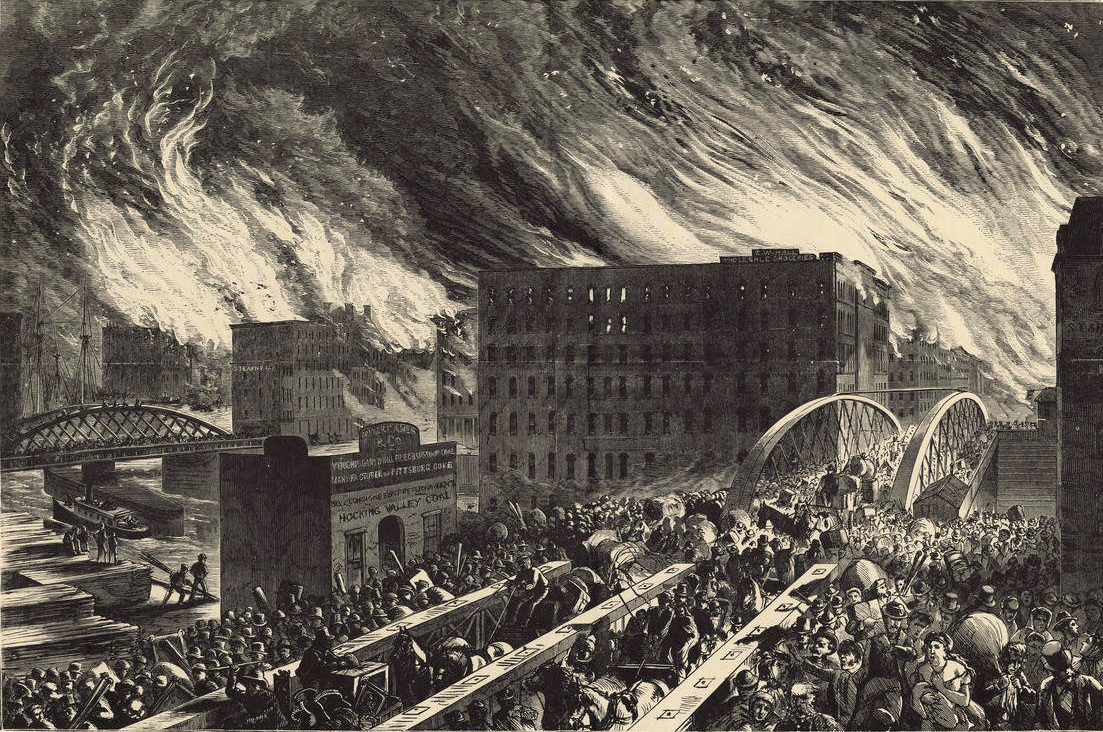In the early night hours of Sunday, October 8, a fire started on the O'Leary property at 137 DeKoven Street that would spread to destroy some four square miles in Chicago and kill hundreds of people. There had been something of a drought, not much in the way of concern for local fire departments, but enough to propel destruction among wooden buildings on a strong wind. With its sudden start and widespread disaster (famously, even the Moody church burned), citizens were highly suspicious of arson and searched for a scapegoat.
At the time, Michael Ahern was a reporter for the Chicago Republican. He had heard the rumor that the O'Learies (Catholic immigrants, prime targets for suspicion already) had negligently allowed their cow to kick over a lantern and then letting the fire go out of control. Other stories told of sneaked smokes by youngsters and thieves starting the blaze while attempting to steal milk. Ahern was about to write a story blaming specifically Mrs. O'Leary as some "colorful copy" when he came upon an even more exciting topic.
Fires had started suddenly throughout the Great Lakes region nearly simultaneously over the weekend. Peshtigo, WI, and surrounding villages had undergone an enormous blaze that killed some 2,000 people and torched millions of acres. Urbana, IL, over one hundred miles south of Chicago had also burned, as had Holland, Mansitee, and Port Huron in Michigan. Even Windsor, Ontario, in Canada burned on the 12th. News about the disasters trickled out slowly, but various cases of eyewitnesses noted smokeless balls of blue fire falling from the sky. After some consideration, Ahern wrote a shocking story that the origin of the Chicago fire had come from the heavens.
Other tabloids picked up the notion, and the idea seared into the Chicagoan public imagination. Scientific persons scoffed at a "rain of meteors" since they would be cool to the touch by the time they landed, but few listened to them. Instead, as Chicago underwent an incredible reconstruction program, observatories and atmospheric study stations were included. In 1882, a more serious proposal of the meteors was announced, and now the scientific community listened. Some began to argue for the mysterious "ball lightning", but the suggestion was now officially in the journals. By the time of the 1893 World's Fair in Chicago, a great wealth of knowledge was collected in the Meteor Hall, which afterward would be donated to Northwestern University.
Two decades later, Robert H. Goddard, a sickly part-time instructor at Clark University began soliciting funding for experiments with rockets. While the Smithsonian offered a princely sum of $5000, Northwestern seized the chance and offered funding as well as a position and student aides. Rockets, the departments affiliated with the study of the cosmos thought, would allow for first-hand exploration of outer space. With his arrival in Chicago, Goddard began intensive plans for high-altitude meteorological instruments and, eventually, designs for a possible, though impractically expensive, orbital rocket. Arguments about propulsion in vacuum dominated much of the rest of Goddard's career.
When the Nazis proved rocketry for military use was successful in the Battle of Britain, the US Army and Navy hurried to update Goddard's designs. While students at the Massachusetts Institute of Technology worked on programmable trainers leading to computing, research at Northwestern led to development of “The Eagle,” or what a jealous Werner von Braun would later call the “V-3.” After the war, USSR would begin the Space Race by launching Sputnik, but Americans would swiftly turn and beat the Russians to the first man in orbit with Alan Shepard. Continual challenges would put men on the Moon with the Apollo program in 1963 and a short-term research station on Mars in 1974. The funding for exploratory rocketry along with the Cold War. By that time, short-range space-travel would prove profitable with hour-long sub-orbit intercontinental flights, zero-g tourism, communication and observation satellites, and Solar Energy Collection stations.
–
In reality, Ahern wrote the story blaming Mrs. O'Leary for the fire. In 1893, he would boastingly confess that he had made up the tale. Catherine O'Leary would die in 1895 of pneumonia, though descendants would say spending the rest of her life under public distrust caused her death from broken heart. Robert Wood would reexamine the meteor theory in 2004, claiming that it might have been methane released from the breakup of Biela's Comet, which would give a brilliant meteoric display in 1872.

No comments:
Post a Comment